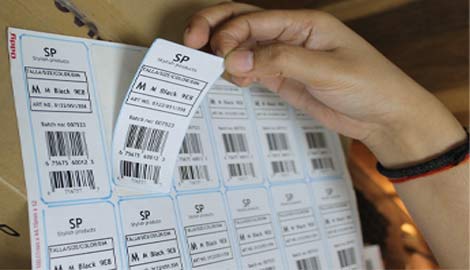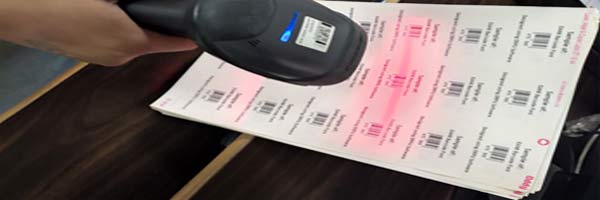Role of Barcode Technology in Retail Business
By: Techsavvy
Published: 20/04/2023
Creating Barcodes for Retail Business
To create barcodes for your retail business, you will need to follow these steps:
-
01
Determine the type of barcode you need:Different types of barcodes have different requirements, so you'll need to determine which type of barcode is most appropriate for your product. Common barcode types include UPC, EAN, and Code 128.
-
02
Obtain a barcode number:You will need a unique number for each product you plan to barcode. You can obtain a barcode number by purchasing them from a barcode provider, such as GS1, or by using a barcode generator that assigns numbers for you.
-
03
Choose a barcode generator:There are many barcode generator software programs available, both free and paid. Choose one that is appropriate for your needs and supports the barcode type you plan to use.
-
04
Enter the barcode number:Once you have your barcode number and generator software, you will need to enter the number into the software to create the barcode image.
-
05
Customize the barcode:Many barcode generator programs allow you to customize the appearance of the barcode, including font size, colour, and label text.
-
06
Print the barcode:Once you have generated your barcode image, you can print it onto your product labels, packaging, or other materials using a barcode printer.
It's important to ensure that your barcodes meet industry standards and are scannable by most barcode scanners to avoid errors and delays in processing sales.

Scan Barcodes for Retail Business:
To scan barcodes in your retail business, you will need a barcode scanner device that is compatible with the type of barcode used by your products. Here are the steps you can follow:
Identify the type of barcode used by your products. Common types include UPC, EAN, and Code 128.
Purchase a barcode scanner device that is compatible with the type of barcode used by your products. You can find barcode scanners online or at electronics stores.
Connect the barcode scanner to your point-of-sale (POS) system or computer using a USB or Bluetooth connection.
Open a barcode scanning app on your device or use the built-in barcode scanner function in your point of sale (POS) system if you have one.
Aim the barcode scanner at the barcode on the product and press the trigger button on the scanner to scan the code.
The barcode scanner will read the code and send the information to your POS software or app, which will retrieve the product information and display it on your screen.
Verify that the product information displayed matches the item you are scanning and proceed with the transaction as necessary.
By scanning barcodes in your retail business, you can improve the speed and accuracy of your transactions, reduce the risk of human error in manually entering product data, and streamline your inventory management processes. Additionally, scanning barcodes can help you generate reports and analytics that provide insights into product sales, trends, and other key performance indicators that can help you make data-driven decisions for your business.
Printing Retail Business Barcodes:
- ➭Choose the type of barcode you want to print. Common types of retail barcodes include UPC (Universal Product Code) and EAN (European Article Number) barcodes.
- ➭Create a product code for each item you want to print a barcode for. This code should be unique for each item and can be generated using a barcode software or manually assigned.
- ➭Enter the product code into your barcode software and select the barcode type you want to generate.
- ➭Adjust the settings for the barcode, such as size, font, and orientation.
- ➭Preview the barcode to ensure it looks correct.
- ➭Connect your barcode printer to your computer and load it with appropriate barcode labels.
- ➭Print the barcode using the barcode software.
- ➭Check the barcode label to ensure it printed correctly and is scannable.
By printing retail business barcodes, you can label your products and streamline your inventory management process. Additionally, printing barcodes can help reduce errors in product identification and price scanning, resulting in faster checkout times and improved customer satisfaction.
Choosing The Right Barcode Scanner For Retail Business
Choosing the right barcode scanner for your retail business requires considering several factors. By considering these factors, you can select the right barcode scanner for your retail business needs. Here are some key considerations:
-
Connectivity:
Determine the type of connectivity that best suits your needs. If you need mobility, consider a wireless or Bluetooth-enabled scanner. If you have limited space or a fixed location, a wired scanner may be more appropriate.
-
Type of barcode:
The first step is to determine the type of barcode you need to scan, such as linear or 2D barcodes. This will help narrow down the options for scanners that can read your specific barcodes.
-
Ease of use:
Consider the user-friendliness of the scanner, especially if multiple employees will be using it. Look for scanners with intuitive interfaces and ergonomic designs that reduce user fatigue.
-
Durability:
If your scanner will be used frequently, consider the durability of the device. Look for scanners that can withstand drops or other impacts, as well as those that are water-resistant or dust-proof.
-
Compatibility:
Check the compatibility of the scanner with your POS or inventory management system. Make sure the scanner is compatible with the software you are using.
-
Scanning distance:
Consider the scanning distance you need for your retail environment. If you have items that are further away, you may need a scanner with longer range capabilities.
-
Budget:
Finally, consider the cost of the scanner and determine a budget that works for your business.

Integrate Barcodes with Retail Management System
Integrating barcodes with your existing retail management system can help you automate your retail processes, reduce errors, and improve the overall efficiency of your business. Here are some steps you can take to integrate barcodes with your retail management system:
-
Choose a barcode system that is compatible with your
retail management system:
Ensure that the barcode system you are using is compatible with your retail management software. Check with the software provider or documentation to see if they have any recommended barcode scanners or systems.
-
Set up your retail management system to accept barcode
data:
Configure your retail management system to accept and process the barcode data. This may involve mapping the barcode data to the appropriate fields in your retail management software.
-
Scan barcodes to update inventory and sales data:
Use a barcode scanner to scan the barcodes on your products at various points in the retail process. This will update your inventory and sales data in your retail management system, allowing you to track which products are selling well, which products are in stock, and which products need to be reordered.
-
Print barcode labels for your products:
Use a barcode printer to print barcode labels for your products. These labels can be affixed to the products themselves, to product packaging, or to shelf tags or other displays.
-
Generate barcodes for your products:
Use a barcode generator to create barcodes for your products. Ensure that each barcode is unique and corresponds to a specific item in your inventory.
-
Test the integration:
Test the integration between your barcode system and retail management software to ensure that the data is transferred correctly and that the systems are working together as intended.